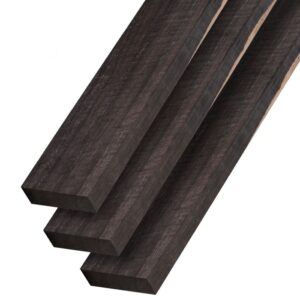/ˈɛbəni/
Ebony Wood: The Epitome of Elegance and Exquisite Craftsmanship
In the realm of fine woods, ebony stands as an emblem of magnificence and opulence. Revered for its deep, lustrous black hue and unparalleled density, ebony wood has enthralled craftsmen, artists, and connoisseurs for centuries. Its history is intertwined with tales of grandeur, luxury, and meticulous artistry, making it an enduring symbol of excellence in craftsmanship.

Examples of the deep black hue of Ebony wood.
Origins and Characteristics
Ebony wood is derived from the Diospyros genus of trees, which belong to the Ebenaceae family. This rare and precious wood is predominantly found in regions of Africa, Sri Lanka, India, and Southeast Asia. The name “ebony” itself carries an air of mystique, thought to have been derived from the ancient Egyptian word “hbny,” meaning black wood.
Ebony is characterized by its deep black color, although variations in shade may occur, ranging from a rich, dark brown to a true black. Its dense and fine-grained structure contributes to its distinctive elegance and mirror-like finish. The wood is renowned for its natural lustre, which can be further enhanced through polishing and finishing techniques. Whenmeticulously polished, it can even emulate the sheen of metal.
Historical Significance
Ebony wood has a storied history that spans continents and epochs. In ancient Egypt, it was highly prized and reserved for the elite, often utilized for intricately carved sarcophagi, ornate furniture, and religious artifacts. The Greeks and Romans also held ebony in high esteem, using it for exquisite sculptures, musical instruments, and intricate inlays.
Throughout the Middle Ages and the Renaissance, ebony continued to be a symbol of luxury and refinement. European monarchs and nobility adorned themselves and their palaces with ebony-crafted pieces, including furniture, cabinets, and decorative objects. In the East, ebony was revered for its spiritual significance, often used in the creation of religious icons, statues, and intricate carvings.
Ebony holds significant symbolism in Pagan beliefs, representing power, purity, balance, and protection. Pagans hold the belief that this specific tree possesses the ability to enhance magnetic energy.

Ebony paired with high polished silver in the Collezione XXI Black Diamond Necklace.
Craftsmanship and Artistry
The allure of ebony lies not only in its natural beauty but also in the extraordinary skill required to work with it. Craftsmen who undertake the art of working with ebony demonstrate exceptional patience, precision, and a deep understanding of the wood’s unique properties. Its density can make it challenging to carve, but the results are unparalleled. Master artisans have created intricate motifs, delicate filigree, and awe-inspiring sculptures, all showcasing ebony’s innate elegance
Contemporary and Sustainable Usage
In modern times, ebony wood retains its aura of sophistication and is still prized for its applications in fine furniture, musical instruments, and luxury goods. However, concerns over deforestation and illegal logging have prompted efforts to promote sustainable harvesting and responsible sourcing of ebony. Initiatives aimed at protecting these remarkable trees and supporting local communities have gained traction, ensuring that future generations can continue to appreciate the allure of ebony. You can check what woods along with other species are protected on the ICUN red list.
Conclusion
Ebony wood is more than just a material; it is a testament to human creativity and the pursuit of excellence. Its rich history, unmatched beauty, and the craftsmanship it inspires make it a timeless symbol of elegance. As we navigate an era that values sustainability and conscientious consumption, ebony’s legacy reminds us of the importance of preserving natural resources while continuing to celebrate the splendor of this remarkable wood. Ebony serves as a poignant reminder of the essential need for clarity when making choices that will shape the destinies of future generations.
Coming up next in our series is an uncommon wood, yet one that leaves a lasting impression with its stunning coloration. Be sure to revisit next month for a detailed exploration of Padauk.

